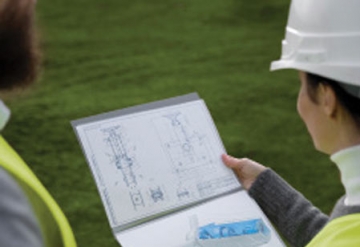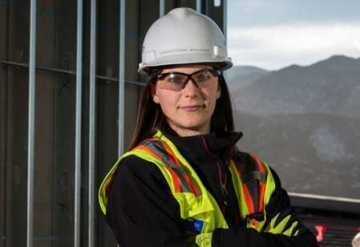THANK YOU FOR SUBSCRIBING

Driving Digital Innovation in Architecture and Engineering
Michael Warren, Associate Vice President - Digital Practice Innovation, AECOM

 Michael Warren, Associate Vice President - Digital Practice Innovation, AECOM
Michael Warren, Associate Vice President - Digital Practice Innovation, AECOMRecognizing Michael Warren’s extensive leadership in digital practice innovation at AECOM, this exclusive feature offers invaluable insights into the challenges of integrating advanced technologies with traditional engineering practices and strategies for driving customer-focused digital transformation in the AEC industry.
Building a Career at the Intersection of Technology and Design
I started my career with a focus on technology and design at Carnegie Mellon University, developing expertise in digital transformation through roles in Code Enforcement, Manufacturing, Construction and Architecture. With a degree in Architecture and a Masters in Public Policy and Management, I gained practical experience in construction projects emphasizing innovative solutions. Over 32 years in the AEC industry, I integrated Building Information Modeling (BIM) and digital twins to enhance project efficiency and accuracy. Leading pioneering projects, I revolutionized infrastructure delivery with these technologies. My commitment to continuous learning led me to the role of Associate Vice President of Digital Practice Innovation at AECOM, where I advance technological innovations in architecture and engineering, including Machine Learning from Large Language Models and Artificial Intelligence applications.
I faced several challenges in aligning digital initiatives with traditional architectural and engineering design practices. Resistance to change was a primary obstacle, as established methods often overshadow new technologies. To address this, I highlighted the tangible benefits of digital tools, like improved project efficiency and accuracy, through pilot projects and real-world examples.
“Through learning, adaptation, and innovation, I successfully integrated digital technologies into traditional practices, keeping customers at the core of the strategy”
Integrating Building Information Modeling (BIM) and digital twin technologies into existing systems required understanding both practices and bridging the gap between them. I fostered collaboration across multidisciplinary teams to ensure seamless integration.
Maintaining customer-centric digital initiatives was crucial. By keeping communication lines open, seeking feedback, and adjusting strategies based on client needs, I built trust and support for the initiatives. Data analytics played a key role in this approach.
Through learning, adaptation, and innovation, I successfully integrated digital technologies into traditional practices, keeping customers at the core of the strategy.
Driving Innovation with 3D Printed Concrete and Customer-Centric Strategies
Digital design tools combined with 3D printed concrete have transformed architectural creativity and client customization. Architects can now explore complex geometries and innovative forms with precision, creating bespoke designs tailored to clients’ needs.
The flexibility of 3D printed concrete allows custom components to align perfectly with the architect’s vision. This collaboration fosters a more iterative design process, enabling quick adjustments to meet specifications. Clients can actively participate in the design process, visualizing and refining ideas in real-time. Quick and cost-effective prototypes enhance satisfaction as clients see tangible results. This integration pushes the boundaries of innovation and ensures projects reflect clients’ desires.
To ensure the quality and structural integrity of 3D printed concrete components, advanced simulation techniques can predict material behavior, mitigating issues before they arise. Rigorous testing protocols validate performance against safety standards. Continuous monitoring during curing with sensors and real-time analytics ensures optimal strength and consistency. Collaboration with material scientists informs additive selection and mix designs, enhancing performance. Quality control at every production stage guarantees safety and reliability, while digital design tools allow for creative, customized architectural solutions.
3D printed concrete reduces environmental impact by cutting material waste and using recycled materials. It is energy-efficient, requires less formwork and lowers transportation costs. 3D printed buildings also offer better insulation and innovative designs, reducing energy usage and supporting sustainable architecture.
Leading Through Change and Inspiring Teams in a Digital World
I evolve my leadership style by embracing technology and fostering innovation. I ensure our teams stay updated on emerging technologies to enhance efficiency and creativity. Open communication and collaboration are key, encouraging idea-sharing for collective success.
I lead by example, engaging in work alongside the team to inspire excellence and a customer-first mindset. I seek feedback from customers to ensure our offerings meet market demands. By cultivating trust and empowerment, I motivate teams to take ownership of projects and strive to exceed customer expectations while meeting contractual obligations and financial responsibilities.
I invest in continuous learning and professional development to keep teams agile and passionate about their work. My dynamic leadership helps navigate technological changes and promotes a customer-centric culture that drives digital transformation.
Leaders should focus on understanding and anticipating customer needs as the basis of their business strategies. By listening to customers and using data-driven insights, they can create valuable solutions. Cultivating an agile and innovative culture is crucial, where team members are encouraged to experiment and improve. Leaders should invest in their teams’ development to adapt to the digital landscape. Transparent communication within the organization and with customers fosters trust and collaboration, building strong relationships that drive loyalty and success. My advice emphasizes a balanced approach, combining technology proficiency with customer satisfaction to drive digital transformation.
Read Also
The evolution of commercial office developments through digital twins
Navigating the MITS Landscape in an AI-Focused Future
Embedding QHSE Excellence in Global Engineering Operations
Sustainability In Construction - The Startups Tackling The Challenge
The Thursday Morning Sprint: A Lesson in Preconstruction Planning
AI's Impact on Construction Workflow Automation

 Copyright © 2025 All Rights Reserved | by:
Copyright © 2025 All Rights Reserved | by: Construction Tech Review
| Subscribe | About us | Sitemap| Editorial Policy| Feedback Policy














